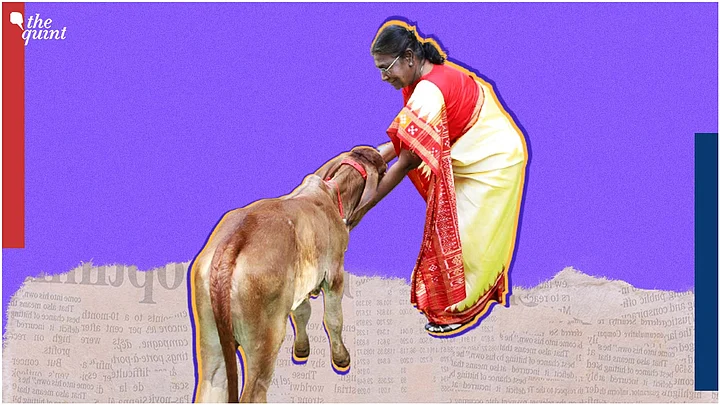In a major breakthrough, scientists at Karnal's National Dairy Research Institute created the world's first cloned buffalo calf in 2009, using an indigenous cloning mechanism. Although the calf, who was named Samrupa, succumbed to a lung infection days after her birth, it put India among the select few nations capable of cloning animals.
The National Dairy Research are back again with another breakthrough – this time, the institute has again used indigenous mechanism to clone a female calf.
Named Ganga, the calf was born on 16 March, weighed 32 kg at the time of birth, and is "growing well," according to the institute. And, on 25 April, she even met India's President Droupadi Murmu who congratulated the National Dairy Research Institute for developing "technology to produce clones of high milk yielding buffaloes and cows."
So, how was the cloning done? Why was the Gir breed chosen for cloning?
Explained: How Did Scientists Clone Gir Cow Ganga? What Makes the Breed Special?
1. How Was the Cloning Process Carried Out?
"As per Prime Minister Narendra Modi's directions to increase milk yield, we have started cloning the high-yield cows using the cloning technique," said Dr Manmohan Singh Chauhan, Vice Chancellor of GB Pant Agriculture University.
Dr Chauhan was the head of the Karnal-based institute when it started work on cloning indigenous breeds like Gir, Red Sindhi and Sahiwal breeds in 2021.
Further elaborating on the process, Dr Naresh Selokar, who is part of the team working to develop indigenous methods to produce cloned cattle, told The Quint:"To clone the Gir, oocytes are isolated from live animals using ultrasound-guided needles, and then, matured for 24 hours under control conditions. The somatic cells (any cell of a living organism apart from the reproductive cell) of elite cows are used as donor genomes, which are fused with OPU-derived enucleated oocytes. Following chemical activation and in-vitro culture, the developed blastocysts are transferred into recipient mothers to deliver the Gir calf."
The advantage of using this technique is that the calf of desired sex is produced.
Expand2. But Why the Gir Breed?
The institute's director Dheer Singh told The Quint that indigenous cattle breeds such as Tharparkar, Gir, Sahiwal, and Red Sindhi are important to boost the country's milk production and the growth of the dairy industry.
"Gir cattle are very hardy and well-known for their tolerance to conditions of stress and resistance to various tropical diseases. Outside India, Gir cattle are quite popular and have been exported to Brazil, the United States, Mexico, and Venezuela for the development of zebu cows," he added.
Amid the Centre's push to increase milk production, he said, "We expect that a cloned cow will produce 15-20 liters of milk per day. The milk production capacity can be increased with good nutrition and better management."
Apart from increasing milk production, scientists claimed the research could prove to be a major milestone in the conservation of the indigenous breeds of cattle on the verge of extinction.
Expand
How Was the Cloning Process Carried Out?
"As per Prime Minister Narendra Modi's directions to increase milk yield, we have started cloning the high-yield cows using the cloning technique," said Dr Manmohan Singh Chauhan, Vice Chancellor of GB Pant Agriculture University.
Dr Chauhan was the head of the Karnal-based institute when it started work on cloning indigenous breeds like Gir, Red Sindhi and Sahiwal breeds in 2021.
Further elaborating on the process, Dr Naresh Selokar, who is part of the team working to develop indigenous methods to produce cloned cattle, told The Quint:
"To clone the Gir, oocytes are isolated from live animals using ultrasound-guided needles, and then, matured for 24 hours under control conditions. The somatic cells (any cell of a living organism apart from the reproductive cell) of elite cows are used as donor genomes, which are fused with OPU-derived enucleated oocytes. Following chemical activation and in-vitro culture, the developed blastocysts are transferred into recipient mothers to deliver the Gir calf."
The advantage of using this technique is that the calf of desired sex is produced.
But Why the Gir Breed?
The institute's director Dheer Singh told The Quint that indigenous cattle breeds such as Tharparkar, Gir, Sahiwal, and Red Sindhi are important to boost the country's milk production and the growth of the dairy industry.
"Gir cattle are very hardy and well-known for their tolerance to conditions of stress and resistance to various tropical diseases. Outside India, Gir cattle are quite popular and have been exported to Brazil, the United States, Mexico, and Venezuela for the development of zebu cows," he added.
Amid the Centre's push to increase milk production, he said, "We expect that a cloned cow will produce 15-20 liters of milk per day. The milk production capacity can be increased with good nutrition and better management."
Apart from increasing milk production, scientists claimed the research could prove to be a major milestone in the conservation of the indigenous breeds of cattle on the verge of extinction.
